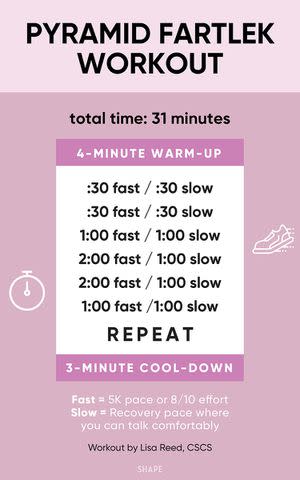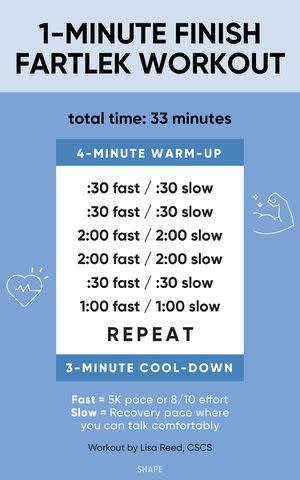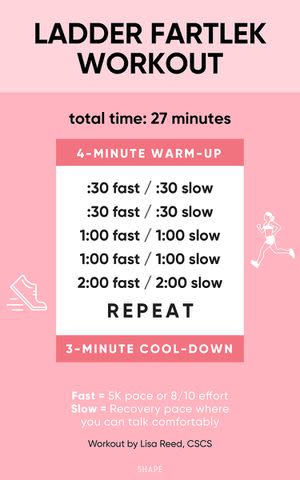What Is a Fartlek Run?
The word sounds silly, but a fartlek running workout is crucial if you want to push your speed and endurance.

A fartlek run sounds like some kind of terrifying gastrointestinal issue you might face after running too many miles. Luckily, the reality is way less intimidating. In fact, a fartlek run is an essential type of run in your training program. Here's what to know about fartlek training and how to add fartleks to your running routine.
What Is a Fartlek Run?
"The word 'fartlek' comes from Swedish and means 'slow play' or, more generally, 'slow fast,'" explains Lisa Reed, a certified strength and conditioning specialist based in Napes, Florida. Basically, a fartlek is a type of run where you vary your speed throughout versus going at a steady pace.
:How to Start Running for Beginners
"Fartlek workouts entail fast or intense running interspersed with periods of active recovery (jogging)," she explains. Your periods of fast running shouldn't be all-out sprints, but something more similar to your 5K pace, or an eight out of 10 effort on the rate of perceived exertion scale (FYI, here's what that means). During your slower periods, you should be running at a pace where you're able to hold a conversation, so you can fully recover.
Theoretically, a fartlek is a type of interval training, but it's special because you never actually stop and rest. "Fartlek workouts are different from interval running because of the work-to-rest ratio," says Reed. "During a fartlek workout, you switch between fast and slow running. During intervals, you move from speed to walking or complete rest." TL;DR: In a fartlek run, you never stop running.
Why You Should Try Fartlek Training
To run fast, you need to train fast — that's why any kind of speedwork is important in a runner's training plan. This particular kind of speedwork matters because fartlek runs teach you how to relax and recover without stopping, and pick the pace back up again when you need to.
:How Tempo Running Can Make You a Faster, More Efficient Runner
"I like to think of fartlek runs as an opportunity for my athletes to get in some speed work without the stress of feeling like they need to hit specific interval times," explains Kim Peek, a USA Track and Field-certified running coach. "A fartlek run helps runners learn that they have more than one speed and that they're also able to slow [down], without walking, to a pace where their heart rate can recover after a harder effort."
Fartleks can help you understand your effort or intensity level while you're running without relying on data from a watch or treadmill — an important skill for pacing yourself in long-distance events such as a half or full marathon. "Runners tend to become dependent on their watches," says Peek. "A fartlek run teaches you to be adaptable and run based on how you feel rather than worrying about paces and time goals."
:How Mindful Running Can Get You Past Mental Roadblocks
"Fartlek runs will help boost endurance while also building speed," explains Peek, because they tax both the anaerobic and aerobic systems. By incorporating different types of runs into your training plan (such as fartlek, intervals, or steady state runs), you can train multiple energy systems in your body, which can improve your performance on race day and make you fitter overall.
How to Do a Fartlek Running Workout
"A fartlek can be as hard or as easy of a run as you need it to be," says Peek. Not feeling your best? Use your fartlek run to alternate between easy jogging and a steady running pace. Or, if you're ready for a challenge, push yourself by switching between your conversational pace and hard sprints.
By definition, fartleks should be unstructured. That makes them an easy running interval workout to do on your own. "If you listen to music, let the song dictate your pace," suggests Peek. "Run at an easy pace during the verse, and pick things up during the chorus." Or, "use landmarks as guides to change your pace. Run [past] five trees at an easy pace, then run harder for two," she adds.
If you prefer something a little more structured (just for guidance), try one of the fartlek workouts from Reed below. You can do them on a track or out on the road or trail. "Each one begins with a four-minute warm-up period of light jogging, which is immediately followed by the fartlek," she explains. You'll continue alternating between hard fartlek efforts and slower recovery runs before finishing with a three-minute cooldown period of walking or jogging. (If you want a quick, intense treadmill workout, try this 20-minute HIIT treadmill workout instead.)
Just don't get totally caught up in the numbers. Fartleks aren't about hitting a certain pace or time, but they are a way to get to know your pace while distracting yourself from your discomfort — because that's where you become a faster runner.



false

